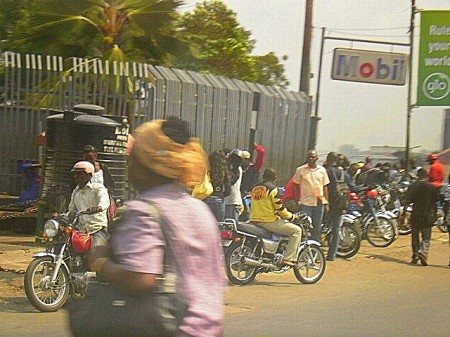
This blog post is part of a series of contributions documenting time spent in southern Nigeria to attend a conference and gather data for the targeting energy infrastructure (TEI) project.
Prior to arriving in Nigeria, I heard about ‘Okadas‘ which are 2-wheel and 3-wheel commercial motorcycles found throughout cities in Nigeria. In reading up on domestic travel options I found that Okadas were commonly described in a negative light – often associated with the words “dangerous” and “reckless”. However, as I entered Lagos and saw the densely populated metropolis in action I saw the Okada system first-hand, and overall I couldn’t help but be impressed.
Rather than view this system through a negative prism I saw another expression of African, and in this case Nigerian, societal ingenuity at work despite living in challenging conditions. In a land where the development of strong state institutions is constantly being challenged by corruption, which hinders the reliable delivery of public goods (decent roads and public transportation), civil society emerges as the engine of service; utilizing creative solutions harvested from below that circumvent the restraints that come from above.
After spending a few days in Lagos, the significant role that Okadas play not only to mass city transit but also as a form of employment to many, mainly young males who operate as drivers became clear to me. Bikes are more affordable and fuel efficient than cars, which is important given that gasoline shortages are an all to common feature in Nigeria. Granted, locals will quickly note how Okada drivers tend to aggressively push through traffic, ignore signs and motorists, and often take chances that can lead to fatal accidents. In fact, looking around one can quickly see that most bikes operate without helmets. Regardless, many admitted to using and benefiting from the service- some more often than others. In one particular conversation, a Nigerian friend told me that while she does not normally use Okadas she revealed that when running late for a meeting she has found herself on the back of a bike, cutting through traffic in the hopes of reaching her destination both quickly and in one piece. I also spoke with a few Okada drivers who shared with me the sense of pride they had in both having wheels to get around and being able to use it as a source of income.

 In the wake of the news that a Russian investment company had coughed up $200 million for a 2 percent stake in Facebook (and yes, that amounts to an estimated $10 billion value for the whole thing), and that Facebook itself had reached the coveted 200 million user mark (making it the 5th largest “country” in the world, no less), I thought it appropriate to have a look at how it is being used in the world beyond the college dorm and my living room.
In the wake of the news that a Russian investment company had coughed up $200 million for a 2 percent stake in Facebook (and yes, that amounts to an estimated $10 billion value for the whole thing), and that Facebook itself had reached the coveted 200 million user mark (making it the 5th largest “country” in the world, no less), I thought it appropriate to have a look at how it is being used in the world beyond the college dorm and my living room.